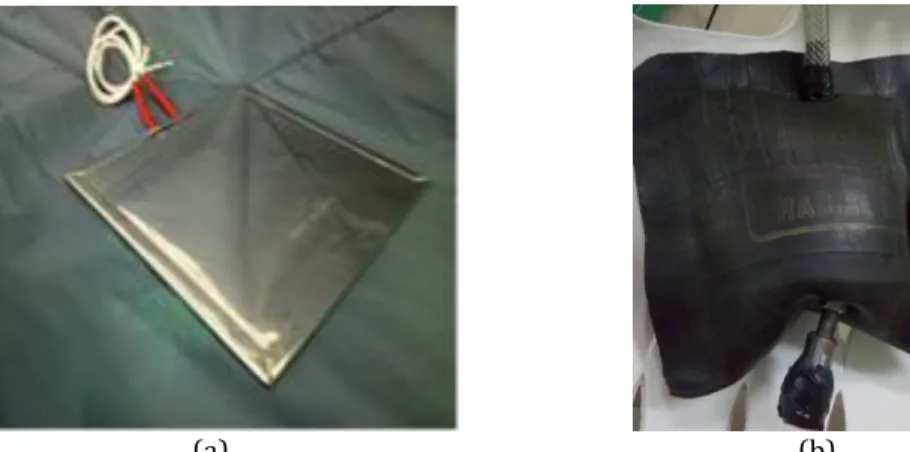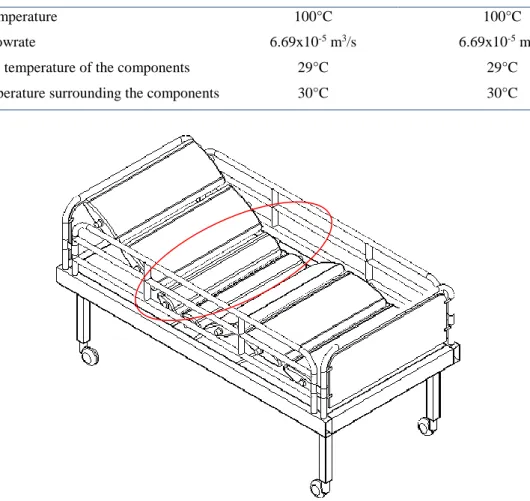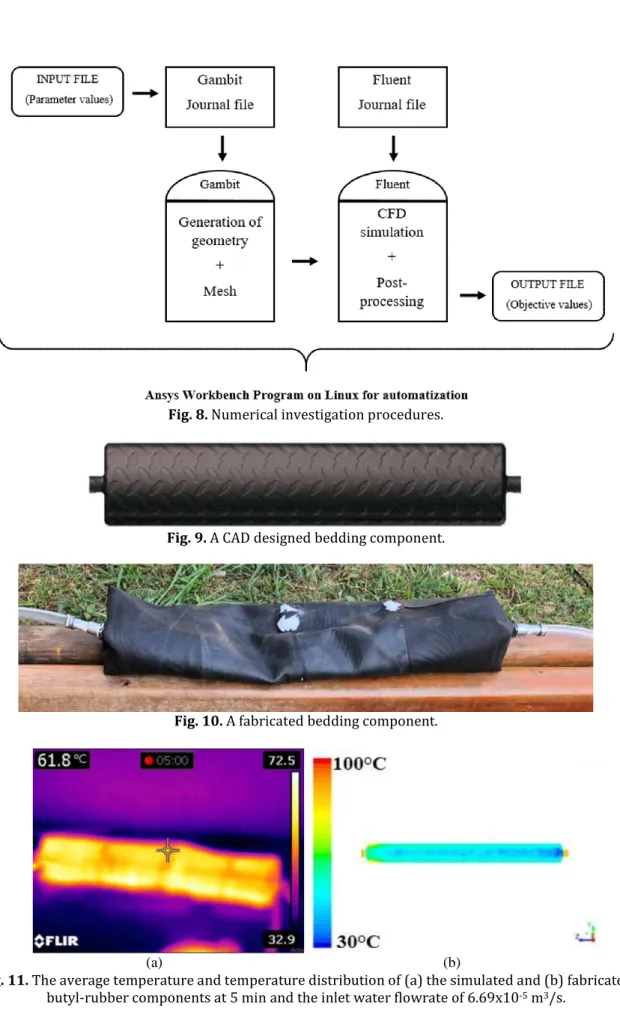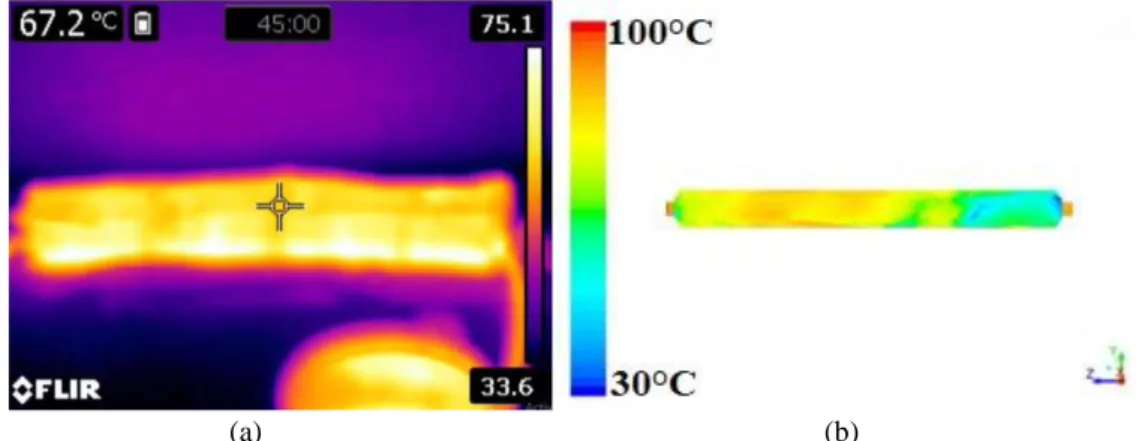Transactions of the TSME (2019) Vol. 7, No. 1, 71-82
Journal of Research and Applications in Mechanical Engineering Copyright © 2019 by TSME
ISSN 2229-2152 print DOI: 10.14456/jrame.2019.7
Research Article
A TEMPERATURE DISTRIBUTION STUDY IN A HEATED BED
COMPONENT MADE FROM BUTYL RUBBER FOR DUST MITE
ALLERGY PATIENTS
A. Pramuanjaroenkij1
J. Bunta1,*
S. Phankhoksoong1
S. Kakac2
1 Faculty of Science and
Engineering, Kasetsart University, Chalermphrakiat Sakon Nakhon Province Campus, 59 Moo.1, Muang, Sakon Nakhon, 47000, Thailand
2 Department of Mechanical
Engineering, TOBB University of Economics and Technology, Sogutozu, Ankara 06560, Turkey Received 4 May 2019
Revised 19 June 2019 Accepted 21 June 2019
ABSTRACT:
Asthma is one of many respiratory tract diseases and can be caused by allergy symptoms. Allergy symptoms can be stimulated by many substances, dust mites are among them. Dust-mite feces can trick the allergy symptom in the patients. Allergy significantly affect quality of patient life. Environment surrounded the dust-mite allergy patients should be controlled to reduce a number of dust mites, the dust mites cannot survive in places where temperature is above 60°C and more than 45 min. This work focused on investigating temperature distributions on a heated mattress component made from butyl rubber, numerically and experimentally. Results were used to evaluate possibility to fabricate dust-mite-free bedding components using butyl rubber since mattress and pillow can be homes of million dust mites. The component was designed by computer aided design (CAD) based on a hospital-bed-mattress shape. The component was also designed to be fed with hot water to heat its surface temperature up to the unacceptable living conditions of dust mites. The component was fabricated locally by using recycle butyl rubber sheets. From simulation results with the flow rate of hot water inlet at 6.69×10-5 m3/s and 100°C, temperature distributions of the surface could be maintained above 60 °C throughout 45 min. Experimental results at the approximate inlet flow rate showed that temperature distributions of the component surface were also above 60°C for the same duration. Therefore, both results showed potentials of the design to be developed as the dust-mite-free bedding components to help creating dust-mite-free environments for the dust-mite allergy patients.
Keywords: Dust Mite, Allergy, Bedding Component, Heat Transfer, Fluid
Flow
1.INTRODUCTION
Allergy affects many patients, it can cause asthma and reduce quality of patient lives. There was a report stating that 70% of global people were affected by allergy [1]. Allergy is caused by many stimulants depending on patients such as dust, dust mites, food, etc. When the patients take their stimulants into their bodies, the bodies will react to these stimulants faster and worse than normal people. There are numerous body reactions to these stimulants; itchiness, tearing, running nose, sneezing and swollen tissues. The worst swollen tissues around ears, noses, throats and mouths can block air ways causing lower oxygen level in patient organ systems. The swollen tissues can even
* Corresponding author:J. Bunta E-mail address: jittraporn.bt@gmail.com
cause severe organ failures. One of the stimulants; which can be found in natural environments and in households, is a dust mite that can survive by consuming dandruffs, scurf and dead skin. Dust-mite-allergy can be detected by allergy medical specialists who perform allergy tests; for an example is the skin allergy testing or skin prick testing. The specialists always recommend their patients to avoid contacting their stimulants and to control their environments to be stimulant-free environments. To get rid of dust-mite feces, one may get rid of dust mites and the feces. The dust-mite feces can be eliminated their stimulant affects by coldness while the dust mite cannot survive in environments with temperature above 45°C longer than 40 min [2].
Wadsö and Svennberg [2] introduced their important information about dust mites. The activity of House Dust Mites (HDM) as a function of humidity and temperature was experimentally investigated by applying a laboratory culture of Dermatophagoides farina (Df) as the scientific name of the dust mites. They measured the heat produced by the mite respiration. They found that HDM activity generally decreased after about one month. The cause of lower HDM activity was expected as their food supply which did not last longer than one month. The important information was delivered from this work with different humidity levels that the Dermatophagoides farina died after 40 min exposure to 45°C environment.
There are limited numbers of the bedding products and patents which use heating concepts and relate to health and dust-mite issues. Many commercial vacuum cleaners were claimed to be able to take dust mites out of beds such as MARTEX® [3], BOSCH® [4] and Phillips® [5]. The manufacturer of MARTEX® vacuum cleaner claimed that the
company use water and High Efficiency Particulate Filters (HEPA) as dust-mite traps, the company also claimed to trap dust mites with the operating time about 15 to 20 min per one matter. Robert Tinnel [6] obtained United States Patent for Water Bed as shown on Fig. 1. Water Bed combined of a box foundation on which rests an upwardly opening rectangular coffer formed by a polyurethane sheet and a polyurethane perimetrical member disposed thereon. He designed the coffer cavity to receive and contain a shallow water mattress. A foam pad was design to be disposed over the mattress. He used the foam construction as the need for a mattress heater, and to attenuate resonant frequency phenomena of the mattress. The foam perimeter was based on the use of standard fitted sheets. Lee Cunningham [7] obtained United States Patent for Heated Bed for Animals as shown on Fig. 2. He claimed that this bed was suitable in the care and treatment of sick, injured, weak or young animals such as dogs and cats, reptiles and birds. He designed the bed combined of a support that includes an outer container of any suitable material having attached thereto or integral therewith a heating unit, such as an electrical resistance heater. He also designed thermostatic controllers to control the heat of the electrical heater which was carried by conduction from the outer shell to the animal resting area.
Fig. 1. Water bed designed by Robert Tinnel [6].
Derek P. Dotson [8] obtained United States Patent for Control System for Fluid Filled Beds as shown on Fig. 3. He designed a system for automatically controlling, fluid pressure was maintained in a plurality of fluid-filled cylinders supporting a sleep surface in order to maintain a desired degree of firmness/softness. The system could operate on two modes; 1) the system permits the user to set the desired level of firmness and then the system acts to maintain that level and 2) the user is enabled to manually activate either the pump or the vent in order to vary the firmness to his choice. Shang-Tai Kuo [9] obtained United States Patent for Multi-Function Healthful Bed as shown on Fig. 4. He designed a multi-function healthful bed including a bed frame, a bottom bed board, an eccentric motor, four elastic feet supporting four feet of the bed frame, four swayable rods placed on four corner feet of a support plate, a massage bar, an air percolating plate, and a pillow. He installed air valves fixed in the upper bed board which allow air to flow an air chamber around the body of a user and to circulate warm or cool air.
Fig. 3. Control system for fluid-filled beds designed by Derek P. Dotson [8].
Fig. 4. Multi-Function Healthful Bed designed by Shang-Tai Kuo [9].
An experimental and numerical investigation on thermal performance in a uniform wall heat-fluxed tube inserted with 45º inclined oval–pentagon rings (OPR) for turbulent flow region using air as the working fluid was performed by Chingtuaythong and Chokphoemphun [10]. They found that their numerical and experimental results were in good agreement, an average deviation of both results was within ±7% for Nusselt number and ±10% for friction factor.
In this study, a bedding component was design based on the hospital-bed-mattress shape. Two different heating systems; electric heater and hot water, were preliminary evaluated to find their potentials. Then, the designed component was fabricated locally by our team. While the numerical investigation to find temperature distributions on the component surface was performed, the experimental setup was designed and fabricated by using butyl rubber sheets to investigate temperature distributions on the surface of the fabricated component. Temperature distribution results were compared and concluded for possibility and potential of the design to be developed as the dust-mite-free bedding components to help creating dust-mite-free environments for the dust-mite allergy patients.
2.EXPERIMENTAL SETUP
Firstly, two heating systems were experimentally studied. One was a direct heating system by a plate heater (Fig. 5a) and another one was an indirect heating system using hot water as a heat transfer media. The indirect
system combined of two types of bedding components, one was an available commercial rubber bag (Fig. 6b) and another was an in-house-made butyl-rubber bag (Fig. 5b). Therefore, three fabricated bedding components consisted of 1) the plate heater covered with the synthetic-fabric pillow (Fig. 6a), 2) the commercial rubber bag (Fig. 6b) and the hot water supplying system and 3) the in-house-made butyl-rubber bag (Fig. 5b) and the hot water supplying system. The most workable system from the preliminary experiment was chosen as a main set to design the bedding component. This research designed the heated bedding components as a circled part in Fig. 7 by using the computer aided design (CAD) program. The designed component was experimentally and numerically investigated to find the temperature distributions. The infrared thermometer camera FLIR E40 (R) was used to measure the temperature distributions and average temperatures of the fabricated-bedding component surfaces. All temperatures were measured and recorded real-time since the heating system started and during the experimental investigations.
3.NUMERICAL INVESTIGATION
While the fabricated components and the heating systems were investigated, the designed bedding component was numerically investigated as procedures in Fig. 8 by using the commercial Computer Fluid Dynamic (CFD) program, Fluent®. The governing equations in the numerical simulation were as following;
Conservation of Mass 0 i i U x (1) Conservation of Momentum 1 1 0 i j j i i j i j i U U U U P x
x
x x
x (2) Conservation of Energy
ρ
p.
tD C T
k T
D
2 2 2 2 2 2 2 i u v w u v u w v w S x y z y x z x z y
(3)4.RESULTS AND DISCUSSION
4.1 Verification of the preliminary study
Among all three fabricated bedding components in the preliminary study, the 900 W plate heater (Fig. 5a) was chosen to heat the first fabricated bedding component. The commercial rubber bag (Fig. 6b) and in-house-made butyl-rubber bag (Fig. 6b) and in-house-made butyl-rubber bag (Fig. 5b) were attached with connectors of a hot water tank. The infrared thermometer camera was used to measure the temperature distributions on bedding component surfaces. The experimental conditions were set as same as indicated in Table 1. The fabricated component which was heated by the plate heater was burned (Fig. 6a) within 1 s after the heater started working while the commercial rubber bag was damaged (Fig. 6b) by heat from the fed hot water after the water was fed into the bag for 8 s. From experimental results, the surface temperature of the in-house-made butyl-rubber bag reached 60 °C in 40 s and could be maintained above 60°C. Therefore, the butyl-rubber bag and the hot water supplying system were the only workable set practically because the workable set could be heated above 60°C more than 45 min without any damages occurred.
(a)
(b)
Fig. 5. (a) a plate heater and (b) an in-house-made butyl-rubber bag in the preliminary setup.
(a)
(b)
Fig. 6. Unworkable components; (a) the burned component by the heater and
(b) the damaged rubber bag. 4.2 Temperature distributions of the simulated and fabricated components
After the butyl-rubber prototype was proved as the workable component, the butyl-rubber bag was designed according to the hospital-bed mattress as the circled part shown on Fig. 7. The component was drawn using CAD and fabricated locally as 150 mm in width, 800 mm in length and 80 mm in height, shown on Figs. 9 and 10, respectively. The CAD component was simulated to find surface temperature distributions by using Fluent with simulation conditions as shown in Table 1. Numbers of elements and nodes were 2607 and 4499, respectively. Three repetitions were performed in each investigation. Temperature obtained from the results were averaged and analyzed. From simulation results, the temperatures of the component surface reached 60°C within 2.20 min. Figs. 11b, 12b, 13b and 14b were temperature distributions and average temperatures of the components obtained from one simulation in 5, 15, 30 and 45 min of the simulations, respectively, after the surface temperatures were over 60°C. In the initial experimental investigations, we fed hot water at 100°C to the fabricated component and
found that its water tube and connectors were deformed. Consequently, hot water at 90°C as informed on Table 1 was fed to the component. The surface temperatures of the fabricated component obtained from the infrared thermometer camera were displayed on Figs. 11a, 12a, 13a and 14a in accordance with the simulated results. From experimental investigations, temperatures of the component surface reached 60°C within 4.50 min. The difference between heating periods of the simulations and experiments may be caused by properties of the butyl rubber sheet in the simulations, as well as different ambient temperatures of the simulations and experiments. Thermal conductivity of the practical butyl rubber sheet is higher than that of the simulated sheet. We observed that, within the first five-min period of the heating time, the surface temperatures of the simulated component were averaged at 93.0°C and the temperature distribution was not uniform. In the same period, the average temperatures of the experimental component was at 61.3°C and the temperature distribution was also not uniform. Figs. 11 to 14 obtained in 15, 30 and 45 min of the investigations also demonstrated that the average temperatures and the temperature distributions of the simulated and experimental bedding components were getting closer than the beginning of the heating period. The average surface temperatures provided by the simulation were 90.0, 91.0 and 90.0 in in 15, 30 and 45 min of the investigations, respectively. The average surface temperatures recorded by the camera were 68.0, 67.1 and 86.5, respectively. We also considered to use natural rubber sheets to build a bedding component. We input properties of natural rubber sheets as mentioned in the literature [11] to find numerical results. The temperature distributions of the natural rubber component were displayed in Figs. 15b, 16b, 17b and 18b. We found that the numerical results changed when the component properties were adjusted. One may observe that the thermal conductivity of natural rubber is low, the conductivity effects the temperature distributions, the lower thermal conductivity the higher differences between simulated and experimental results.
Table 1: Working conditions for the experiments and the simulated bedding component in the CFD program. Conditions Simulation Experiment
Inlet water temperature 100°C 100°C
Inlet water flowrate 6.69x10-5 m3/s 6.69x10-5 m3/s
Initial surface temperature of the components 29°C 29°C
Ambient temperature surrounding the components 30°C 30°C
Fig. 8. Numerical investigation procedures.
Fig. 9. A CAD designed bedding component.
Fig. 10. A fabricated bedding component.
(a) (b)
Fig. 11. The average temperature and temperature distribution of (a) the simulated and (b) fabricated
(a) (b)
Fig. 12. The average temperature and temperature distribution of (a) the simulated and (b) fabricated
butyl-rubber components at 15 min and the inlet water flowrate of 6.69x10-5 m3/s.
(a) (b)
Fig. 13. The average temperature and temperature distribution of (a) the simulated and (b) fabricated
butyl- rubber components at 30 min and the inlet water flowrate of 6.69x10-5 m3/s.
(a) (b)
Fig. 14. The average temperature and temperature distribution of (a) the simulated and (b) fabricated
(a) (b)
Fig. 15. The average temperature and temperature distribution of (a) the simulated and (b) fabricated
natural-rubber components at 5 min and the inlet water flowrate of 6.69x10-5 m3/s.
(a) (b)
Fig. 16. The average temperature and temperature distribution of (a) the simulated and (b) fabricated
natural-rubber components at 15 min and the inlet water flowrate of 6.69x10-5 m3/s.
(a) (b)
Fig. 17. The average temperature and temperature distribution of (a) the simulated and (b) fabricated
(a) (b)
Fig. 18. The average temperature and temperature distribution of (a) the simulated and (b) fabricated
natural-rubber components at 45 min and the inlet water flowrate of 6.69x10-5 m3/s.
4.3 Temperature distributions of the simulated and fabricated components
We defined a dimensionless temperature by a component surface temperature divided by the inlet water temperature. The average dimensionless temperatures of both surfaces; the simulated and experimental component surfaces, at different periods of times (as displayed on Figs. 11 to 14) were plotted in Fig. 19. We noticed that both lines; the simulation and experiment, on Fig. 19 revealed the same trend. If one feed the higher temperature water to the component, one can expected the higher temperatures on the surface. The differences between both results may be caused by the butyl properties. Since combinations of butyl rubber sheets depend on the rubber producers and are kept as patents, the exact values of the input properties were not common. We aim to use the simulation to predict temperatures of the bedding surfaces when inlet temperatures of hot water are changed for different purposes, the combined components can be combined and used as antidecubitus mattresses [12]. The butyl-rubber made component was proved its possibility and potential to be the heated bedding component on the hospital bed. This design could be fabricated and tested for its surface temperatures. The temperatures could be maintained over 60°C and 45 min.
0
0.20.4
0.60.8
10
5
10
15
20
25
30
35
40
45
50
D im e n si o n le ss Tem p e ratu re s Time (min.) Simulation ExperimentFig. 19. The average dimensionless temperatures of the simulated and fabricated
butyl-rubber components.
5.CONCLUSION
The objectives of this work were to design, to fabricate, to evaluate the heating bed components and, finally, to find possibilities and potentials of the components. The workable component was developed as the dust-mite-free
environmental conditions around the patients. Since bedding components or mattresses touched the patients every day, the bedding components were focused in this work. The mattresses can be suitable places for dust mites to live because they provide food (dead skin and dandruff) and dust-mite living temperatures. As mentioned in the literature [2], the dust mites can be killed by maintaining their living environment above 60°C at least 45 min. For the preliminary study, three fabricated components were experimentally investigated to find the workable components. The experimental results of primary three bed components revealed that the direct heating system, by the plate heater, damaged the bed component. The component surfaces near the heater were burned. After the commercial rubber bag was fed with 100°C water, the edges of the commercial bag was damaged. Thus, the commercial bag was not workable. The last investigation was focused on the in-house-made butyl-rubber bag, the only fabricated bed component with no damage occurred during the preliminary investigation. The design component based on a hospital-bed part was drawn by using the CAD program and simulated to find its temperature distributions and average temperatures by using Fluent. The component was also fabricated domestically and experimentally evaluated its practical potential and possibility. Results from both simulations and experiments revealed that this design could be used as the hospital-bed component. The experimental results showed that the surface temperatures of the fabricated components were higher than 60°C. We can also maintain the surface temperatures above 60°C during 45 min of the experimental period. Therefore, the butyl-rubber sheets with the in-house-made fabrication showed its possibility and potential to be improved as the dust-mite-free bedding components of the hospital beds for the dust-mite allergy patients to improve their quality of life.
Acknowledgments
This work was financially supported by STEM academic staff development funding project (Science, Technology, Engineering and Mathematics academic staff development funding project), Kasetsart University Research and Development Institute and Office of Chalermphrakiat Sakon Nakhon Province Campus, Kasetsart University, Chalermphrakiat Sakon Nakhon Province Campus. We would like to thank you our research team; Achita Butrakon, Phalinee Noisuan, Suwimon Tiyarach, Nattamol Wongpat, Seomsuk Akhotmi and Sittichai Chaiga.
NOMENCLATURE
Cp specific heat of fluid, J/kg-K D diameter of pipe, mm Dt same diameter of pipe, mm
k thermal conductivity of fluid, W/m-K T temperature, K Si Source Term P pressure, Pa u,v,w velocity x,y,z coordinate μ dynamic viscosity, kg/m.s ρ fluid density, kg/m3 Subscripts
CAD computer aided design CFD computer fluid dynamic Df dermatophagoides farina HDM house dust mites
REFERENCES
[1] Thai Health Promotion Foundation, Four of the most found allergies in Thai people, Digital Object Library,
Thai Health Promotion Foundation Thailand, URL: https://dol.thaihealth.or.th/Media/Index/59fb334b-392e-e711-80dc-00155dddb706?isSuccess=False, accessed on 06/04/2018.
[2] Wadsö, L. and Svennberg, K. Bedrooms without house dust mite: final report from a preliminary study, 2005, Division of Building Materials, Lund University.
[4] Bosch-home, Vacuum Cleaners, Indonesia, URL: http://www.bosch-home.co.id, accessed on 06/04/2018. [5] Philips, Mite Cleaning Vacuum Cleaner, Singapore, URL: https://www.philips.com.sg, accessed on
06/04/2018.
[6] Tinnel, R. United States Patent, Water Bed, 1977.
[7] Cunningham, L. United States Patent, Heated bed for animals, 1982. [8] Dotson, D.P. United States Patent, Control system for fluid-filled beds, 1991. [9] Kuo, S.T. United States Patent, Multi-function healthful bed, Taiwan, 1997.
[10] Chingtuaythong, W. and Chokphoemphun, S. Thermal performance augmentation in heat exchanger tube with oval–pentagon rings, Transactions of the TSME: JRAME, Vol. 6, 2018, pp. 50-62.
[11] Wangchai, S. Kolitawong, C. and Chaikittirattana, A. Finite element analysis of heat generation in particle
filled natural rubber valcanizates during cyclic deformation, Applied the Journal of KMUTNB., Vol. 21(1)Jan.-Apr., 2011. pp. 14-21.
[12] Jonsson, A., Lindén, M., Lindgren, M., Malmqvist, L.A. and Bäcklund, Y. Evaluation of antidecubitus mattresses, Med. Biol. Eng. Comput., Vol. 43(5), 2005, pp. 541-547.
![Fig. 2. Heated bed for animals designed by Lee Cunningham [7].](https://thumb-eu.123doks.com/thumbv2/9libnet/3747072.27848/2.808.225.611.856.977/fig-heated-bed-animals-designed-lee-cunningham.webp)
![Fig. 4. Multi-Function Healthful Bed designed by Shang-Tai Kuo [9].](https://thumb-eu.123doks.com/thumbv2/9libnet/3747072.27848/3.808.288.535.453.672/fig-multi-function-healthful-bed-designed-shang-tai.webp)





